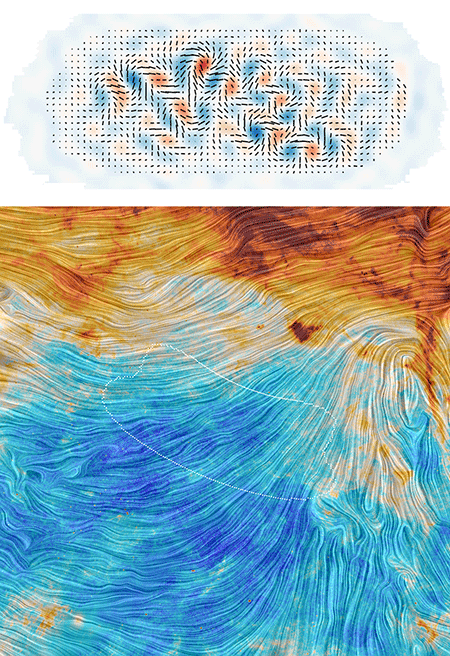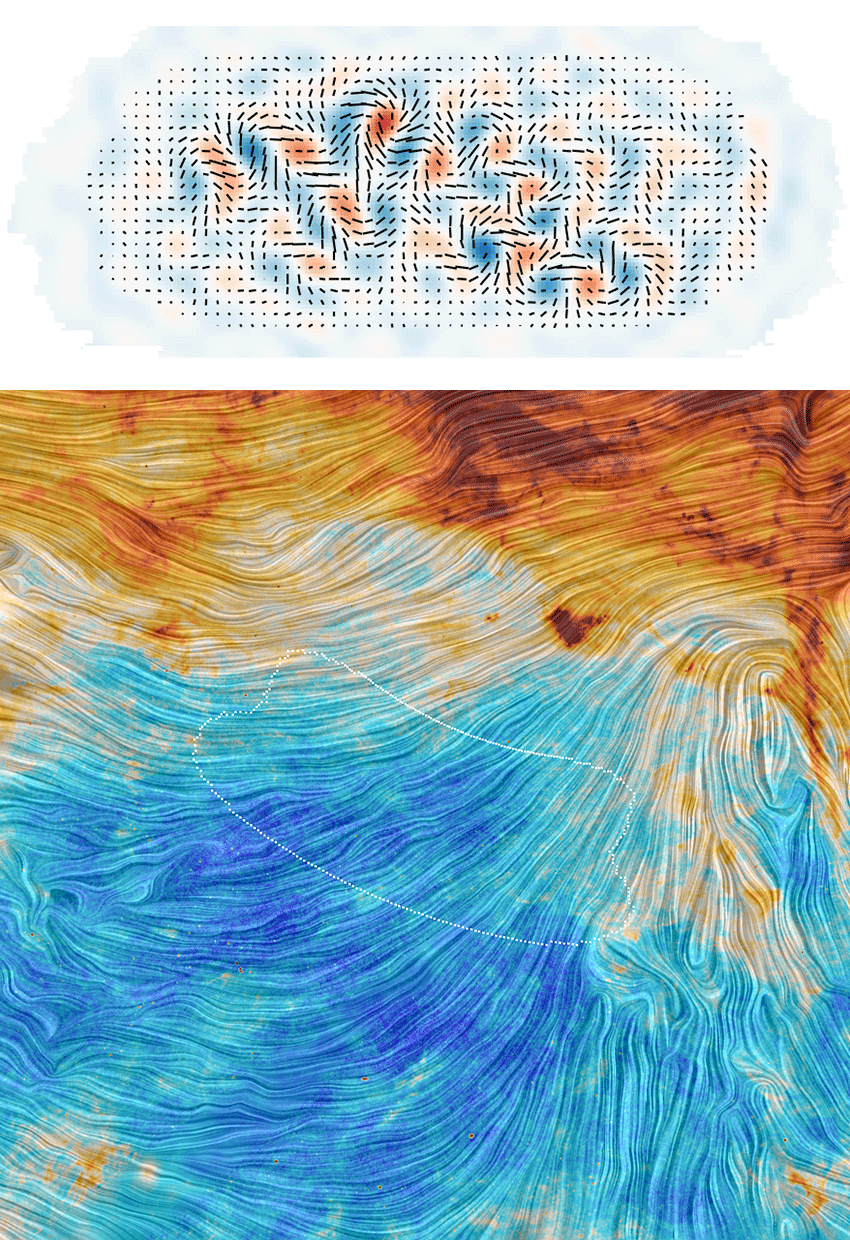A Clearer View of a Dusty Sky
The theory of inflation hypothesizes that the Universe underwent a period of rapid expansion less than seconds after its birth [1]. If inflation occurred, physicists believe it would have produced large-scale gravitational waves, imprinting a slight swirl-like polarization—known as modes—on the cosmic microwave background (CMB), the light generated when the Universe was 380,000 years old [2,3]. In March of 2014, scientists observing the CMB with the BICEP2 microwave telescope announced they had detected this faint polarization signal, setting off shockwaves in the scientific community and capturing the public’s imagination (see Ref. [4] and 19 June 2014 Viewpoint). Now, a new joint analysis [5] by the BICEP2 team and the collaboration analyzing CMB data from the European Space Agency’s Planck satellite confirms what a number of scientists had suspected: the BICEP2 signal was contaminated by interstellar dust, which can emit polarized radiation at microwave frequencies. Based on their analysis, the teams have concluded there is no significant evidence for an inflationary signal. The result is certainly a major setback for the BICEP2 team. But for current and future experiments, the analysis serves as a guide for performing sensitive measurements, leaving open the possibility that an inflation signal will ultimately be detected.
Much of our knowledge about the origins of the Universe and its earliest moments comes from measurements of subtle angular anisotropies (amplitude fluctuations from point to point in the sky) in the temperature and polarization of the CMB. To date, measurements of temperature anisotropies in the CMB have confirmed several key predictions of inflation theory: the Universe is spatially flat, and it was seeded with a scale-invariant random distribution of density (scalar) fluctuations that led to the clustering of matter in the Universe [6].
An additional prediction of inflation—gravitational waves—has proven much harder to detect in the CMB. These waves are tensor—as opposed to scalar—perturbations to the geometry of spacetime and would result in CMB temperature and polarization anisotropies that vary on the scale of a few degrees [7]. The amplitude of this inflationary signal is parameterized by the tensor-to-scalar ratio , whose value depends on the energy scale of inflation and other factors (see 19 June 2014 Focus).
Planck’s measurements of CMB temperature anisotropies constrained [8]. But Planck’s ultimate sensitivity was limited because scalar perturbations also produce temperature fluctuations. Measurements of CMB polarization do not have this limitation because, at large angular scales, greater than about one degree in size, inflationary gravitational waves are the dominant mechanism that produces -mode polarization, a spatial pattern of polarization vectors with curl. Inflationary modes are, however, extremely faint: perturbations to the CMB amplitude are predicted to be less than one part in .
The BICEP2 instrument was designed specifically to look for CMB -mode polarization [9]. Situated at the South Pole, the instrument had superb atmospheric conditions and 24/7 visibility of the “Southern Hole,” a low-foreground patch of sky. The telescope was sensitive to light at 150 gigahertz (GHz), near where the CMB spectrum is most intense, and the combined emission from dust and synchrotron foregrounds was thought to be at a minimum.
After three years of data taking, the BICEP2 team announced they had detected a -mode signal (see Fig. 1, top) with a high significance—less than a one-in-a-million chance of the signal being due to random noise [4]. The observed signal was well fit by an inflationary model with a tensor-to-scalar ratio . Based on maps extrapolated from higher- and lower-frequency data, they argued that dust was unlikely to be a significant contaminant. But a few months after BICEP2’s announcement, an analysis of a new polarization map from Planck (see Fig. 1, bottom) indicated that dust could have produced BICEP2’s entire signal [10]. Importantly, Planck’s measurements were performed at a higher frequency of 353 GHz, where dust, which has a temperature around and emits primarily in the far infrared, dominates the signal from polarized light. Yet Planck’s finding had a large uncertainty because the dust signal in the Southern Hole is weak, and it was based on an extrapolation of their data to the lower frequency of BICEP2’s experiment.
In the new paper [5], the BICEP2 and Planck teams have collaborated to perform a more stringent analysis. The teams first spatially filtered the Planck 353-GHz map in the same way as the BICEP2 map was filtered. BICEP2 also added data from their sister experiment, the Keck Array, to their previous map, improving its signal-to-noise ratio. To look for a common spatial pattern, the teams took the spatial Fourier transform (FT) of both the BICEP2/Keck map and the Planck map, then multiplied the results together in what is known as a “cross-correlation.” Processing the data in this way ensures that only -mode polarization patterns present in both maps will multiply coherently as a positive signal. Essentially, the BICEP2/Keck data serve as a spatial template to pick a small signal out of the noisy background in the Planck data. Cross-correlation provides a more precise, and definitive, estimate of the dust contamination in the BICEP2/Keck data than could be inferred by using the Planck data alone.
The teams report that the two maps have a common signal, whose amplitude is similar to that of the signal detected by BICEP2. Since nearly all of the Planck signal was from dust, this suggests that a significant fraction of the BICEP2/Keck -mode signal—and maybe all of it—was also the result of dust. The researchers also fit the data to a model and found an upper limit for the scalar-to-tensor ratio of with confidence, consistent with the previous upper limit from Planck.
After the excitement of BICEP2’s first announcement, this new result may seem disappointing. But the intense publicity and scrutiny sparked by BICEP2’s results have invigorated the field. First, the BICEP2/Keck experiments demonstrated a spectacular and unprecedented level of sensitivity and control of systematic errors: the telescope is an order of magnitude more sensitive than any previous CMB polarization experiment. Second, while the new upper limit on disfavors so-called “natural” inflation, a relatively simple model, many other inflation models predict signals that are below the current upper limit on . These alternative models may be detectable with the next generation of experiments, some of which claim a sensitivity to as small as 0.01. The competition is fierce, with at least six funded ground-based experiments underway (including the third version of BICEP), several balloon-borne experiments, and a number of proposed space missions. Finally, thanks to the new data, galactic foreground contaminants—and strategies for removing them—are now better understood.
This research is published in Physical Review Letters.
References
- For a review, see A. R. Liddle, “An Introduction to cosmological inflation,” in Proceedings of 1998 ICTP Summer School in High-Energy Physics and Cosmology, ICTP Series in Theoretical Physics, Vol. 15, edited by A. Masiero, G. Senjanovic, and A. Smirnov (World Scientific, Singapore, 1999)[Amazon][WorldCat]; arXiv:astro-ph/9901124
- Uros Seljak and Matias Zaldarriaga, “Signature of Gravity Waves in the Polarization of the Microwave Background,” Phys. Rev. Lett. 78, 2054 (1997)
- Marc Kamionkowski, Arthur Kosowsky, and Albert Stebbins, “A Probe of Primordial Gravity Waves and Vorticity,” Phys. Rev. Lett. 78, 2058 (1997)
- P. A. R. Ade et al. BICEP2 Collaboration, “Detection of -Mode Polarization at Degree Angular Scales by BICEP2,” Phys. Rev. Lett. 112, 241101 (2014)
- P. A. R. Ade et al. (BICEP2/Keck and Planck Collaborations), “Joint Analysis of and Planck Data,” Phys. Rev. Lett. 114, 101301 (2015)
- For recent results see P. A. R. Ade et al. (Planck Collaboration), “Planck 2013 results. XXII. Constraints on inflation,” Astron. Astrophys. 571, A22 (2014)
- See, e.g., Prof. Wayne Hu’s CMB tutorial webpage on gravitational waves’ effect on the CMB: http://background.uchicago.edu/~whu/intermediate/Polarization/polar6.html
- P. A. R. Ade et al. (Planck Collaboration), “Planck 2013 results. XVI. Cosmological parameters,” Astron. Astrophys. 571, A16 (2014)
- P. A. R. Ade et al. (BICEP2 Collaboration), “BICEP2. II. Experiment and Three-Year Data Set,” Astrophys. J. 792, 62 (2014)
- R. Adam et al. (Planck Collaboration), “Planck intermediate results. XXX. The angular power spectrum of polarized dust emission at intermediate and high Galactic latitudes,” Astron. Astrophys. (to be published); arXiv:1409.5738





